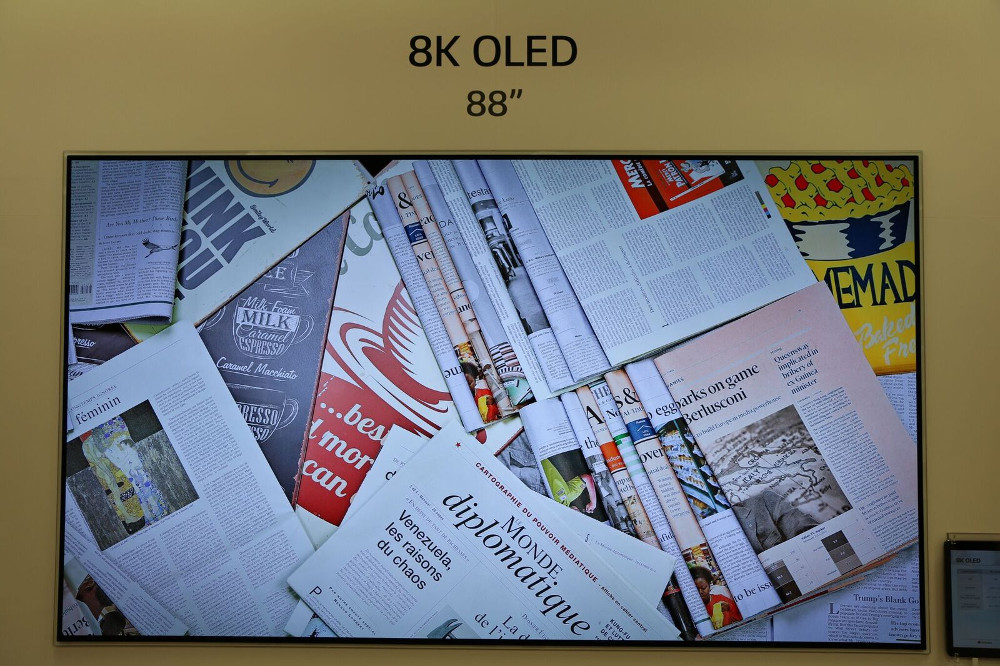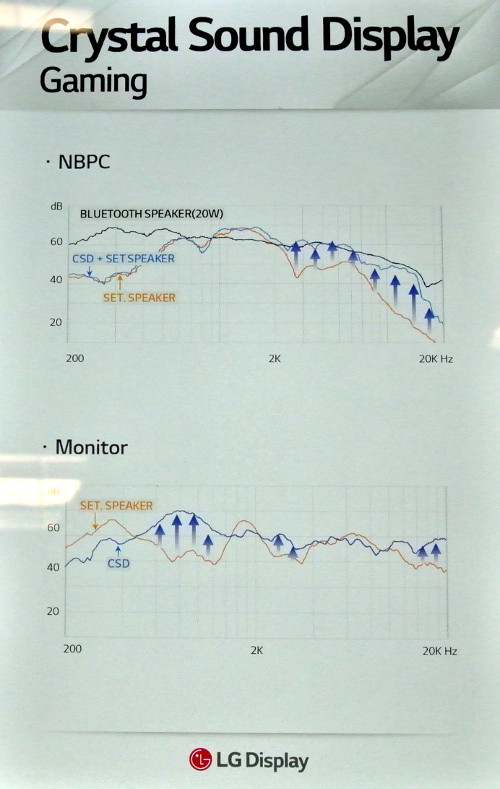LG Display is the OLED and LCD provider to many TV brands including LG Electronics. As usual, they have a special meeting room at CES where they showcased a wide variety of new and innovative displays for TV, monitors, B2B and automotive. These are for their customers to see and decide to use in products.
In TV panels, there were two standout products: a 65” rollable OLED display and an 88” 8K OLED display.
OLED Panels
The rollable OLED 65” UHD display is a prototype, but LGD was actively discussing commercialization with partners at CES, we were told, with products “sooner than you think.” No performance specs were given, but all of the OLED panels seem to have similar performance: 700-900 cd/m² and 95 to 99% P3 coverage.
It deployed from the bottom to the top at CES, but can also be ceiling mounted. The size of the enclosure for the rolled up display was about 12” deep and 16” tall, but LGD thinks this can be reduced. They have been testing the robustness of the rolling reliability and are currently testing it at a rate of 3K deployments per day.
The deployment can be stopped at various positions as well. For example, just showing a small segment can be used as a weather or stock ticker. If you want to show a movie in a native 21:9 (2.35:1) or cinemascope aspect ratio, just deploy it to that preset position when there will be no black bars. Full deployment is 16:9. You can see a video https://www.youtube.com/watch?v=A-Yumjyd-Fs.
LG has trademarked the ‘Roled’ term to cover this kind of technology.
Such a display offers a great value proposition in any home where a big black turned off TV set is not always the most appealing decor in the room. (The Black Hole on the Wall) The display could even sit below a window and pop up when desired.
Many have also theorized that making an 8K OLED display would be too hard. LG Display just proved the critics wrong by showing an 88” version that looked fantastic. Some specs on performance were posted next to it as well. Color gamut coverage is 99% of DCI-P3 (or 129% of sRGB or 93% of NTSC). Luminance was given in three patch sizes: 800 cd/m² in a 10% window; 500 cd/m² in a 25% window and 150 cd/m² for full screen white. These numbers are a bit better than last year’s levels for UltraHD panels and should be consistent with the UHD panels as well.

Only static images were shown, but the clarity of text was fantastic. It is unclear if there are issues with driving video content, but that would not be surprising as a new SoC would likely be needed with more power and speed. Nevertheless, LGD says they are discussing commercialization with partners, but it is unclear if this will be a 2018 product. Smaller panel sizes are possible too, but LGD would not say what they thought the smallest practical size was.
A 77” UHD OLED wallpaper display was being shown as well with a single cable connection that carries power and signal. It is shipping now.
LG Display also commercialized its crystal sound technology last year, which is in the Sony A1E TV. The actuators that mount on the back of the panel were 15.5mm in diameter in 2017, but LG Display showed the 2018 version with actuators that are only 3.5 mm in diameter. This will enable an upgrade from 2.1 to 3.1 channel sound.
This technology can also be implemented on LCDs this year, not just OLEDs. The chart below shows the frequency performance improvement on a notebook PC and in a monitor configuration.

The company then showed a 55” transparent OLED display.
LCD Panels
Turning to LCD displays, the company showed what they called “Art Glass.” This is a glass instead of plastic light guide plate for edge lit LCDs but with no casing covering the back. Instead, the coated the lightguide with black paint with a grid-like clear pattern. This allows the light in the guide to escape out the back in this grid pattern to create an “ambilight-like” effect.
They also showed their Nano Color technology commercialized in 2017 LCD displays. This technology consists of nanometer scale particles that absorb yellow light to help reduce the overlap in the red and green color filters. We were also told that the particle then emits green light, but it is not a quantum dot material. The end result is the final red and green chromaticity values are pushed out toward the spectral locus, allowing higher purity color and a wider color gamut display. Such TVs are now able to achieve 99% of DCI-P3 (85% of BT.2020 or 153% of sRGB and 109% of NTSC). The 65” UHD panel demo was at 700 cd/m² and refreshes at 120 fps.

Samsung used a similar yellow notch filter approach in one line of TVs a couple of years ago but with a film that blocked a lot of light and was dropped. The Nano Color approach would appear to be more efficient.
LG Display is a big proponent of IPS type LCD panels, but it was also showing two 8K 75” VA-type panels as well. One used 1 transistor per pixel and the other used 2 transistors per pixel. The idea was to show the increase in viewing angle possible with the two-transistor design. LGD did not disclose where this was based upon a-Si or Oxide backplane, however. This is also being discussed with partners for commercialization.
Analyst Comment
For more comments on the LG Display suite, see our main report. (BR)

